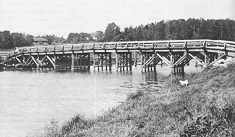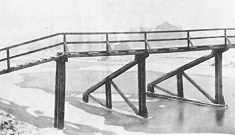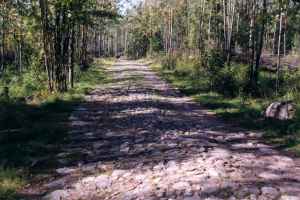Roads
When the war beginning there were two roads to Helsinki. Western road went through the fortress line in Leppävaara and Mäkkylä. Roadsides were also fortified in Ruskeasuo, when the first defense line was built 1914. Eastern road went through the bases IV, IX, X and XIV. Naturally sides of the both roads were strongly fortified. There were openings in the barbed wire obstacles where the road pass trough. Openings were ensured probably with moveable obstacles.
During the war large military road network was built in land front. Old roads improved and totally new roads were built. Roads were strong and hold out against winter and spring conditions. Surface was stones or macadam. Also some new bridges were built, for example over the Vantaa river and from Tarvo to Munkkiniemi.

During the first world war Russian army built bridge over Vantaa river which connected Oulunkylä to Pakila. There was narrower bridge 15 meters upriver which protected the main bridge from ice floes during the spring times. (Photos: Svensk Förening i Åggelby).Old road network facilitated building up new suburban round Helsinki in 1950-70'. Roads were made wider and asphalted. Some roads were saved and they are surprising good condition. However heavy vehicles have damaged some old military roads. Parts of the road network badly damaged 1996 in Kivikko area (base IV), when the new walkways were built. Now the damaged roads have been renovated. Original military roads could be find for example in Länsimäki district (base II).
Railroads
There were two railroads to Helsinki. Other came from west through Leppävaara and Pitäjänmäki and other came from north via Malmi and Pukinmäki. There was a junction in Pasila where the both rails connected and continued to city. Pasila junction was fortified 1914. Military camps located in the sides of the railroads. Stations has naturally guards.
Russians have made large fellings in forests of Finland during the war. Narrow-gauged railways transported timber cargos from forests to main railways. One of the narrow-gauged tracks came from Seutula district via Tapanila to Malmi and the other from Hämeenkylä via Konala to Pitäjänmäki station and from there to Munkkiniemi quay. Third narrow gauged track started from Espoo station to north. After the war all tracks removed. You can still find some short parts of track lines and embankments where the narrow-gauged tracks have been.
Telephone networks
Russian army have own telephone network in addition to civil telephone network in Helsinki area. Main telephone central was in the large underground tunnel in Pasila. There were five telephone centrals in land front: Elfik (nowadays Tapiola), Tali, Lepola, Viikki, Latokartano and Herttoniemi. Centrals of Tali and Lepola were in big shelters. You can still find them. Tali is object XXXV:10 and Lepola XXII:3.
Main telephone central in Pasila was connected to civil telephone central and to sea front central in island of Iso Mustasaari where was also telegraph station. Wireless telegraph station of the Baltic fleet was in the Santahamina island.
© 2000

